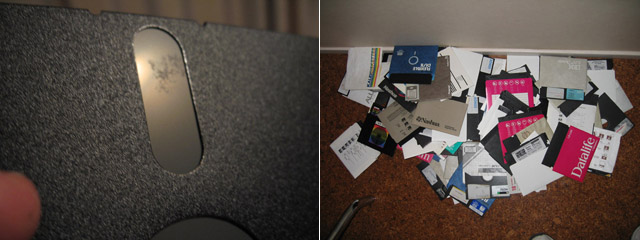tezza
Veteran Member
Hi,
I was helping a friend yesterday transfer all his software and files from single-density, 5.25 inch TRS-80 Model 1 disks into disk images on the PC using a SVD device. Like my own stored collection when I tried this exercise, many of his disks looked like the below.

In the main, these didn't go into my drive but were simply thrown on the discard pile (similar to the discard pile above from an earlier exercise). However, one of these disks (which looked like the above) had some document files on it, which were really important to my friend. Knowing how thoroughly my drive was gummed up last time it tried to read disks like that, I hesitated to even TRY to read the data.
Anyway, my friend had heard of this (last-resort) technique where you cut the disk out of the sleeve and washed the gunk/fungi off with warm soapy water. I was EXTREMELY skeptical about this but as he had nothing to loose, he tried it anyway. The sleeve was cut away and the (now circular) disk duly washed with warm water and liquid soap. Lots of ugly brown gunk came off (better down the drain than on my drive heads!). The mylar was then dried.
He then inserted the disk (without the sleeve) carefully into the 1/2 height drive we were using and clamped it down. The drive was naked, so we could see it was being held into position ok. I then started to copy the files across.
Well, EVERY file was successfully copied and there was NOT ONE parity error in the whole copy episode (about 100k of data)! I was AMAZED and would not have believed it if I hadn't seen it with my own eyes!
Naturally my friend is stoked about this. He's now taken some of the other "rejects" home to cut out and wash. I'll be interested to see if we get the same positive result. I really can't believe it.
It seems floppy disks are far more durable than I gave them credit for. I'm not saying this will work all the time, or at all for others. It may depend on exactly what's wrong with the disk and how the disk was manufactured. However, it definitely worked in this instance. If you have gunk-laden floppies with very important data you really need to get off, and the only alternative is to chuck them, I'd recommend extracting and washing them AS A VERY LAST RESORT.
On reflection I'm glad we didn't try to read this disk as it was. The deposit would have certainly came off and scratched it, making it unreadable washed or not. It would have definitely gummed up the drive.
Tez
I was helping a friend yesterday transfer all his software and files from single-density, 5.25 inch TRS-80 Model 1 disks into disk images on the PC using a SVD device. Like my own stored collection when I tried this exercise, many of his disks looked like the below.

In the main, these didn't go into my drive but were simply thrown on the discard pile (similar to the discard pile above from an earlier exercise). However, one of these disks (which looked like the above) had some document files on it, which were really important to my friend. Knowing how thoroughly my drive was gummed up last time it tried to read disks like that, I hesitated to even TRY to read the data.
Anyway, my friend had heard of this (last-resort) technique where you cut the disk out of the sleeve and washed the gunk/fungi off with warm soapy water. I was EXTREMELY skeptical about this but as he had nothing to loose, he tried it anyway. The sleeve was cut away and the (now circular) disk duly washed with warm water and liquid soap. Lots of ugly brown gunk came off (better down the drain than on my drive heads!). The mylar was then dried.
He then inserted the disk (without the sleeve) carefully into the 1/2 height drive we were using and clamped it down. The drive was naked, so we could see it was being held into position ok. I then started to copy the files across.
Well, EVERY file was successfully copied and there was NOT ONE parity error in the whole copy episode (about 100k of data)! I was AMAZED and would not have believed it if I hadn't seen it with my own eyes!
Naturally my friend is stoked about this. He's now taken some of the other "rejects" home to cut out and wash. I'll be interested to see if we get the same positive result. I really can't believe it.
It seems floppy disks are far more durable than I gave them credit for. I'm not saying this will work all the time, or at all for others. It may depend on exactly what's wrong with the disk and how the disk was manufactured. However, it definitely worked in this instance. If you have gunk-laden floppies with very important data you really need to get off, and the only alternative is to chuck them, I'd recommend extracting and washing them AS A VERY LAST RESORT.
On reflection I'm glad we didn't try to read this disk as it was. The deposit would have certainly came off and scratched it, making it unreadable washed or not. It would have definitely gummed up the drive.
Tez
Last edited:
